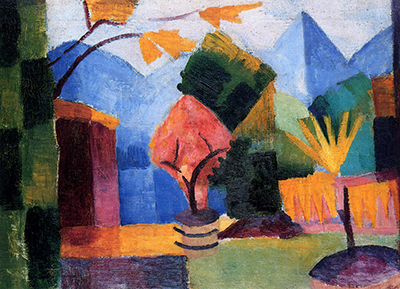The beautiful scenery in and around Lake Thun in Switzerland has been found in the work of notable artists ever since the 17th century and remains much the same today. Macke was just one of a number to recognise its suitability for canvas and paper.
Nature played an important role in much of August Macke's career, often as a supporting feature to his figurative work. In the case of his work in and around Lake Thun, though, his paintings tended to be devoted to the beauty of this region, with no human involvement at all. He was taking advantage of the greater acceptance of landscape painting which had occurred several centuries earlier, and more modern artists were now able to work more freely. Previously, the likes of Cranach and Giorgione were only permitted to display landscape elements within larger compositions with more traditional content accompanying them.
The artist's approach to producing form within this painting was to create outlines of the main objects before then applying paint to complete the piece. He may have used a pencil to essentially sketch the layout whilst sat admiring this stunning view. In using watercolours rather than oils, he most likely would have then completed the artwork there and then, rather than waiting until he had returned to his studio. Most travels that Macke went on would involve carrying the tools required for sketching and watercolour painting, with anything else being considered to cumbersome to complete during the trip itself.
You will quickly identify this painting as being from watercolours, with small gaps between some of the regions of colour. The background hills are formed from tones of blue, and then Macke creates the elements of the garden with a much greater variety of colour - this allows the eye to focus more on the foreground. Purples, oranges and greens treat our eyes to an extraordinary combination of nature with a planned garden.




